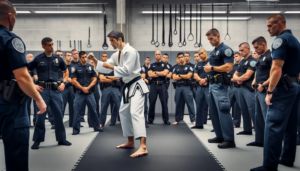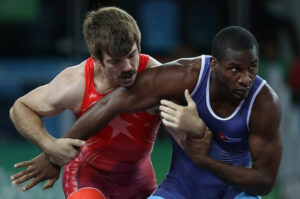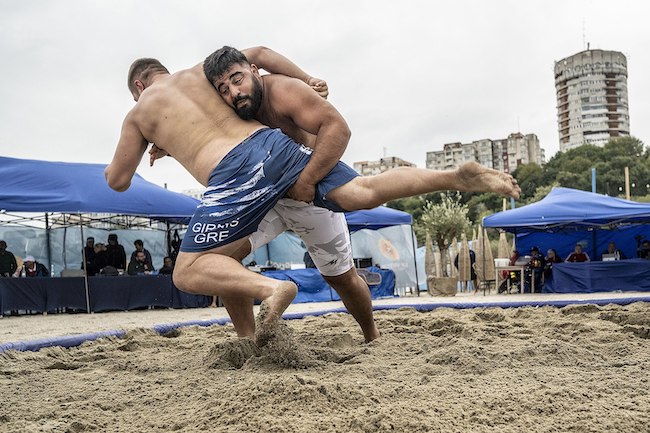
Are you interested in beach wrestling and have some questions about it?
In this article, we go through what beach wrestling is, its history, rules, attire, illegal techniques, scoring, weight classes, and more.
Contents
What Is Beach Wrestling?
Originating as a form of ancient combat and recreational activity, beach wrestling today is recognized as a competitive sport with a global following.
Unlike traditional wrestling, it emphasizes simplicity and accessibility, requiring minimal equipment and setup.
Beach wrestling is a dynamic and fast-paced sport that strips down wrestling to its most fundamental elements: strength, speed, and strategy.
It’s a sport where both men and women compete, showcasing their wrestling prowess on a natural and challenging surface – the soft, shifting sands of a beach.
Beach Wrestling History
Beach wrestling was registered as a type of wrestling in 2004 by the United World Wrestling (UWW), an international governing body.
It’s believed to be one of the earliest forms of human competition, with historical depictions showing wrestlers in the sand as far back as ancient Egypt and Greece.
The modern adaptation is a nod to the sport’s origin, bringing the primal contest back to the sand.
Beach Wrestling Competition Area
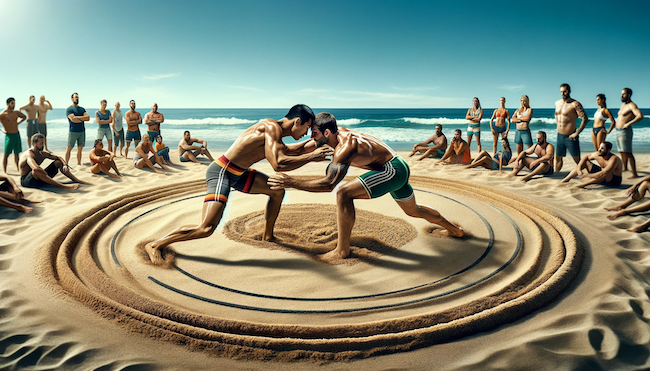
In beach wrestling, athletes compete within a central ring filled with fine sand, spanning 7 meters in diameter.
The ring is made of tape or rope and measures 8-10 cm in width. Some believe rope shouldn’t be used as the ring as it can be dangerous if a wrestler lands on it heavily.
The central ring must be filled with a 30-centimeter layer of fine sand free from any stones, shells, or other potentially harmful objects.
What Are the Beach Wrestling Rules?
The basic rules of beach wrestling include:
- All matches are held in one period of 3 minutes without a break.
- The wrestlers must wear the wrestling uniform as per the UWW regulations.
- Wrestlers who enter the competition area with an appearance that doesn’t conform to UWW regulations are given 2 minutes to change it; otherwise, they lose the match by forfeit.
- The competition is held in a direct elimination system with a consolation round (repechage) for the bronze medal fight.
- The pairing of the wrestlers is done by drawing lots.
- Beach wrestling is only practiced in standing positions.
- The use of the legs is allowed in all actions.
- The attacking wrestler is permitted to touch a knee (or any other part of the body) to the ground while performing a move, provided that the move results in the opponent being taken to the ground.
- However, if the move isn’t completed and/or doesn’t score, 1 point is awarded to the opponent because the knee touched the ground.
- Arrive at the call room sweating for the beginning of the match.
- Wrestlers get a maximum of 2 minutes for an injury timeout. If this time is exceeded, the wrestler is disqualified.
- All wrestlers must submit themselves to the United World Wrestling Anti-Doping Regulations in order to compete.
Beach Wrestling Attire
Based on the official Beach Wrestling Uniform Guidelines from the Beach Wrestling World Series (BWWS) 2021, the attire for beach wrestling is as follows:
Men’s Beach Wrestling Uniform:
- Wrestlers must wear board shorts, biking shorts, or other shorts approved by United World Wrestling (UWW).
- The length of the shorts must stop above the knee and not be shorter than 15 centimeters above the knee.
Women’s Beach Wrestling Uniform:
- Wrestlers must wear board shorts, biking shorts, or other shorts approved by UWW, with the same length requirements as the men’s shorts.
- Women must also wear either a sports bra (preferably) or a form-fitting rash guard.
- The neckline in the front must not be more than 15 centimeters, and the neckline on the back must not be more than 10 centimeters.
- The cut under the arms must not exceed 21.5 centimeters.
Colors:
- To avoid countries wearing the same colors, two uniform options are required: one with light colors and one with dark colors.
- The first wrestler called to compete must wear a light-colored uniform, and the second wrestler must wear a dark-colored uniform.
- Specific color requirements are outlined for both light and dark uniforms to avoid similar color combinations.
Markings:
- The family name and country code must be displayed on the uniform, following specific font and size guidelines.
- The flag or the NF/NOC logo must appear on the front right side of the shorts, and the NF/NOC code must be on the left back of the shorts, below the athlete’s family name.
- Sponsorship placements are allowed in designated areas on the shorts.
Graphics:
- Graphics or traditional designs may be incorporated into the uniform’s design but must adhere to specific guidelines regarding the color base and watermarking.
Ear Protectors:
- Ear protectors must be made of flexible and elastic material without any hard buckle and covered with shock-absorbing material.
Also, beach wrestlers aren’t allowed to:
- Wear the emblem or abbreviation of another country.
- Wear bandages on fingers, wrists, arms, or ankles except in the case of injury and on doctor’s orders (these bandages must be covered with elastic straps).
- Wear any object that might cause injury to the opponent, such as rings, bracelets, prostheses, piercings, etc.
- Wear under-wired bras (women).
- Wear any footwear.
Beach wrestlers must also follow these attire rules:
- Wrestlers’ fingers and toenails must be trimmed so that there aren’t any sharp edges.
- Long-haired athletes must attach them or have a ponytail so that their hair doesn’t interrupt the fight.
- Wrestlers must be well groomed and their hair and skin must be free of any greasy, oily, or sticky substance.
- The referee can require a wrestler to towel off at any time during the match to remove sweat and/or sand.
Beach Wrestling Illegal Techniques
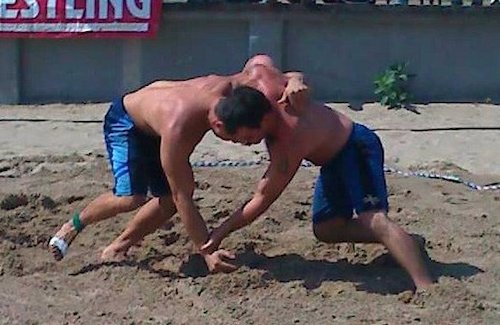
The illegal techniques in beach wrestling are:
- Holds causing dislocations
- Neck cranks
- Biting, punching, kicking, head butts, malicious cross faces
- Gouging of the eyes, ears, or nose, and hooking inside the mouth (fish hooking)
- Tugging on an opponent’s hair, nose, ears, or targeting the groin area
- Standing throws onto the head or neck (spikes)
- Applying any oily or slippery substance to the skin
- Intentionally halting the match or exiting the competition zone without cause
- Feigning an injury to gain an advantage
Note: each illegal technique results in the opponent being awarded 1 point. 3 illegal techniques result in disqualification.
Beach Wrestling Scoring
Beaching wrestling scoring is simple and works like this:
One point is granted to:
- The wrestler who successfully takes any part of their opponent’s body to the sand, excluding the hands.
- The wrestler who causes any part of their opponent’s body to exit the boundaries of the competition zone.
- The wrestler whose opponent is penalized with a caution for an illegal action or technique.
Two points are given to:
- The wrestler who’s able to make their opponent’s back touch the ground during a takedown maneuver.
Note: When a wrestler completes a point-scoring move, the referee blows the whistle, and the time is stopped. The time restarts when the whistle is blown.
How To Win In Beach Wrestling
The victory is awarded to the wrestler who first scores 3 points.
In the event of a tie at the conclusion of the match, the winner is determined based on the following criteria, in order of application:
- The greatest value of holds executed during the match.
- The last point scored in the contest.
- The lighter-weighing wrestler.
- The smallest number pulled during the initial draw.
For number 3, both wrestlers are again weighed post-match and the wrestler who weighs less is declared the winner.
Beaching Wrestling Challenges
Beach wrestling incorporates a unique challenge system (similar to tennis) that ensures fairness and accuracy in scoring and decision-making.
This system allows wrestlers to contest decisions made by referees during a match if they believe a decision is incorrect.
The challenge must be made promptly by saying out loud “challenge” to the referee, immediately after the refereeing body has awarded or failed to award points to the contested situation.
Once a challenge is made, the match is temporarily halted, and the challenged decision is reviewed.
This review is conducted by a panel of officials or referees who were not involved in the initial decision.
They use video replay technology to reassess the contested action.
Each wrestler is entitled to two (2) challenges per event: one during the group stage and the eliminations, and another one during the medal match.
If the challenge is deemed valid, the initial decision is overturned. The correct scoring is then applied, and the match resumes with these adjustments.
If the challenge results in a decision modification in favor of the wrestler who requested it, then the challenge can be used again during the event by the concerned wrestler.
If the challenge isn’t upheld, the original decision stands. In this case, the wrestler loses the challenge, and his opponent will receive one (1) technical point.
No challenge can be requested for penalties given as a result of negative wrestling, nor can it be requested after the end of the regular time of a match, except under specific circumstances.
After reviewing the action and consulting with the refereeing body, the refereeing delegate (or his substitute) renders the final decision, which cannot be discussed or countered.
In cases where an error seriously affects the fair result of a match, the referee delegate (or his substitute) has the right to ask for a Video Analysis Review (VAR) of the action.
Beach Wrestling Weight Classes
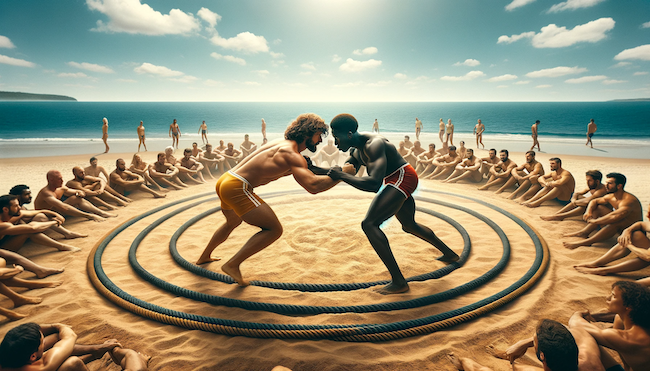
To ensure fair competition, beach wrestling is divided into weight classes. This categorization allows wrestlers to compete against others of similar size and weight, making matches more about skill than size.
The weight classes are also categorized by age and are regularly reviewed to reflect the sport’s evolving demographics and to maintain competitive balance.
Cadets (16-17 years old*)
- Men: 60, 70, +70 kg
- Women: 50, +50 kg
Juniors (18-20 years old**)
- Men: 60, 70, 80, +80 kg
- Women: 50, 60, +60 kg
Seniors (20 and older***)
- Men: 70, 80, 90, +90 kg
- Women: 60, 70, +70 kg
*Cadets (from 15 with medical and parental certificates)
**Juniors (from 17 with medical and parental certificates)
***Seniors (from 18 with medical certificate)
Beach Wrestling Tournaments
Beach Wrestling World Series
The Beach Wrestling World Series, initiated by United World Wrestling, plays a pivotal role in the development and promotion of Beach Wrestling globally.
Aimed at integrating the sport into major multi-sport events, the series comprises several international competitions.
Each event in the series showcases top-tier beach wrestling talent and offers prize money, with a total of 15,000 CHF awarded at each event.
This series represents a significant step in elevating beach wrestling to a more prominent position in the world of sports.
World Beach Wrestling Championships
The World Beach Wrestling Championships is an annual event that brings together the best beach wrestlers from around the globe.
Since its inception, this championship has been instrumental in popularizing beach wrestling worldwide.
The event is known for its high level of competition and serves as a platform for wrestlers to demonstrate their skills on an international stage.
The championship has been organized in a series format since 2019, further enhancing its prestige and appeal.
Youth Olympic Games
Beach wrestling has been featured in the Youth Olympic Games, providing a platform for young athletes to compete at an international level.
This inclusion not only promotes the sport among younger generations but also integrates it into the Olympic movement, highlighting its growing significance and appeal.
Asian Games
The Asian Games, a major multi-sport event in Asia, has included beach wrestling, showcasing the sport’s popularity and acceptance in the region.
This event offers wrestlers from Asia a chance to compete at a high level and gain valuable international experience.
Mediterranean Games
The Mediterranean Games, which brings together athletes from countries around the Mediterranean basin, has featured beach wrestling as part of its sports program.
This inclusion is a testament to the sport’s growing popularity and its appeal across different cultures and regions.
World Beach Games
The 2019 World Beach Games included beach wrestling, marking a significant milestone for the sport.
This global multi-sport event provided an excellent opportunity for beach wrestling to be showcased to a wider audience, further establishing its place in the international sports arena.
Beach Wrestling Organizations
United World Wrestling (UWW)
United World Wrestling is the international governing body for the sport of wrestling, including beach wrestling.
UWW is responsible for overseeing the rules, regulations, and organization of beach wrestling competitions worldwide.
It plays a crucial role in promoting the sport, developing its structure, and integrating it into major multi-sport events.
UWW’s efforts have been instrumental in elevating the profile of beach wrestling on the global stage.
National Governing Bodies
Various countries have their own national governing bodies for wrestling, which often include divisions or committees dedicated to beach wrestling.
These organizations are responsible for promoting and organizing beach wrestling at the national level, developing talent, and selecting athletes for international competitions.
They play a vital role in the grassroots development of the sport and in nurturing future champions.
Overall
Each of these tournaments and organizations plays a crucial role in the development and promotion of beach wrestling.
They provide platforms for athletes to showcase their skills, compete at the highest levels, and contribute to the growth and popularity of the sport worldwide.


